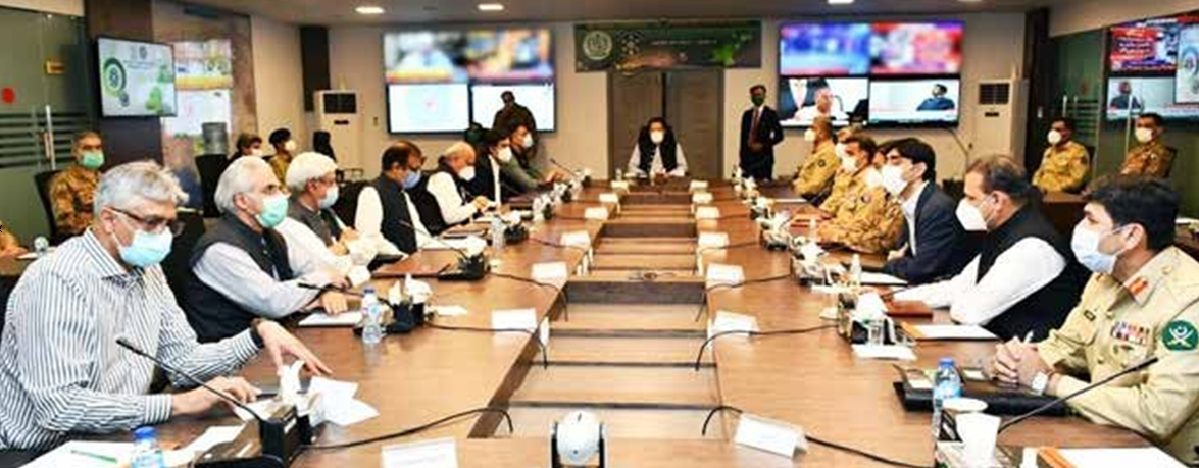After getting off relatively lightly from the first two waves of the Covid-19 global pandemic, Pakistan appears set to suffer some damage at the hands of the third wave of Covid-19 with no coherent national strategy and no mass vaccination program insight.
Already, the UK variant of the virus is taking its toll on the lives of the people and putting an enormous strain on the country’s fragile healthcare system, especially in the federal capital Islamabad and the Punjab province.
As of 25 March, there are about 38,000 active cases of Covid-19 in Pakistan. The number of confirmed cases are nearing 641,000 and more than 14,000 deaths have been recorded. The positivity ratio at this point is above nine percent, which is quite high compared with the first and second waves of the pandemic.
According to the National Command and Operation Centre (NCOC), the rate of people testing positive in June last year was as high as 23 percent but dropped to 1.7 percent by September. It began to increase again, reaching 7.45 percent in January 2021 before dropping to 3 percent by mid-February and then climbing to 7.1 percent in March.
The First Wave
The first case of Covid-19 in Pakistan surfaced on 26 February 2020 in Karachi. The lack of effective quarantine facilities and limited testing capacities at the Taftan border crossing resulted in import of the virus in the country that resultantly played havoc especially in the Punjab and Sindh provinces.
Prime Minister Imran Khan’s government was always hesitant to impose complete lockdown and later introduced a ‘smart lockdown’ concept and the authorities hailed it as an effective tool to curb the virus.
But the sheer scale of outbreak exposed the gaps in the underlying healthcare system. A high population density, lack of public awareness, weak healthcare system, the resistance created by community dynamics and religious and cultural beliefs made the containment of virus a tough challenge in the country.
Initially, at the start of the outbreak in late February 2020 the testing by Polymerase Chain Reaction (PCR) for the virus was very limited and only symptomatic cases with travel history of high-risk countries were tested.
Lack of stringent policy and lockdown gamble paved the way for spread of coronavirus through social, political, religious, and business activities. The schools, colleges and universities were reopened for regular activities across the country.
The data compiled by NCOC revealed that Pakistan reached its first 100 confirmed cases (on 16 March 2020) twenty days after reporting the first case. The count reached 1,000 cases (on 24 March 2020) after 28 days; 10,000 (on 22 April 2020) after 57 days; and 20,000 (on 3 May 2020) 68 days after first reported case.
A total of 332,186 cases of Covid-19 were recorded in Pakistan during the first wave, 6,795 of them resulting in death.
The Second Wave
The government announced the arrival of the second wave of Covid-19 on 28 October 2020 when the daily increase in cases reached 750 compared with 400 to 500 cases a few weeks ago.
Pakistan saw a pattern of the pandemic where the first wave occurred in the spring that substantially subsided during the summer in 2019, while the second wave emerged in the fall of 2020.
It was observed that more people were visiting hospitals during the first wave because Covid-19 was a new infection and there was less or no awareness in masses. But in the second wave people were somewhat aware of it and they preferred to remain in isolation till recovery.
At the peak of the second wave of the pandemic on 25 December, the national positivity ratio averaged at just over six percent, the highest observed in Karachi at
12.45 percent, followed by 10.96 percent in Peshawar and 7.81 percent in Abbottabad.
The Third Wave
The third wave of pandemic again tested the healthcare system as the more virulent and a deadlier UK variant arrived. The positivity ratio raced 12.67 percent on 13 March in Lahore when 991 new cases were reported within 24 hours – the highest number of infections reported in the city in a year.
Earlier on 23 February, the NCOC had relaxed most of the restrictions on commercial activities, schools, offices, and other workplaces. Health experts say this combined with the arrival of the UK variant resulted in sharp spike in cases leading to the third wave of the pandemic.
Pakistan reported more than 3,000 Covid-19 cases for the second day in a row on 19 March as the country teetered in the grip of the deadly third wave of the pandemic.
Irresponsible Attitude
When Pakistan was struggling against a global pandemic like rest of the international community, the attitude of many political leaders including government officials was generally disappointing. They largely failed to make people understand the potential threats related to the virus.
The people saw Prime Minister Imran Khan saying on national television that the Covid-19 would only cause flu and then the patients would regain health. Jamiat Ulema-e-Islam-Fazl (JUI-F) chief Maulana Fazlur Rehman repeatedly made a mockery of the pandemic in his public speeches. Some even maintained Pakistan should go for herd immunity.
The shopkeepers and traders also took no serious measures to implement Standard Operating Procedures (SOPs) introduced by the government to prevent spread of Covid-19. The local administration in the cities took some cosmetic steps but usually avoided taking action against violation of SOPs both by the shopkeepers and the visitors.
Vaccination
In view of the increasing threats to the health of the people, the government decided to initiate vaccination process that could become a game-changer. A total of 104 vaccination centers were initially established across the country but it took them many weeks to start their work due to unnecessary bureaucratic hurdles.
Unfortunately, the government’s response to procure vaccines remains very slow and it is largely eyeing donations to vaccinate the increasingly vulnerable population.
Pakistan received half a million shots of the Sinopharm vaccine as a gift from China in the first week of February. The NCOC started registering frontline healthcare workers to receive the COVID-19 vaccine on 11 January this year. Later, it announced on 15 February that people over the age of 65 should also register for vaccination.
Later, the government announced that walk-in vaccination facilities would be opened from 16 March for people over 70 years of age and they could get vaccinated at the nearest health facility after registering at 1166.
National Health Services Secretary Amir Ashraf Khawaja raised many eyebrows when he informed the Public Accounts Committee the government aimed to combat Covid-19 through herd immunity and donated vaccines and had no plan to purchase doses at least this year.
NCOC head Asad Umer who is also Minister for Planning, Development and Special Initiatives later clarified that 150 million dollars were allocated by the federal cabinet to purchase Covid-19 vaccines. However, there has still been no word of any government plan to purchase and administer vaccines to the general public.
Vaccines Prices
The government has fixed the maximum sale price for the Chinese single-dose Convidecia vaccine at PKR 4,225 per shot. The Sputnik V Russian vaccine at PKR 8,449 for two doses and China’s
The price for the Russian-made two-dose two-vector Sputnik V vaccine (also called Gam-Covid-Vac) has been set at PKR 8,449 per pack of two injections, PKR 16,560 per pack of four injections, PKR 40,555 per pack of 10 injections, and PKR 81,110 per pack of 20 injections.
Myths
Unfortunately, a numbers of myth about the infection and vaccination continue to percolate the society, further undermining any positive messaging and dissuading the masses from taking the requisite safety measures. Some of these myths are listed below.
1) Presence of virus in the vaccine can pose threat to the life of people: The WHO has clarified that there is no live virus in the vaccines, so they cannot infect anyone.
2) The vaccine would alter the DNA of the people. Scientists say injecting RNA into a person doesn’t do anything to the DNA of a human cell.
3) If you get vaccinated, it could make you infertile. There is absolutely no data from the clinical trials nor any theoretical reason for the vaccines to cause infertility.










